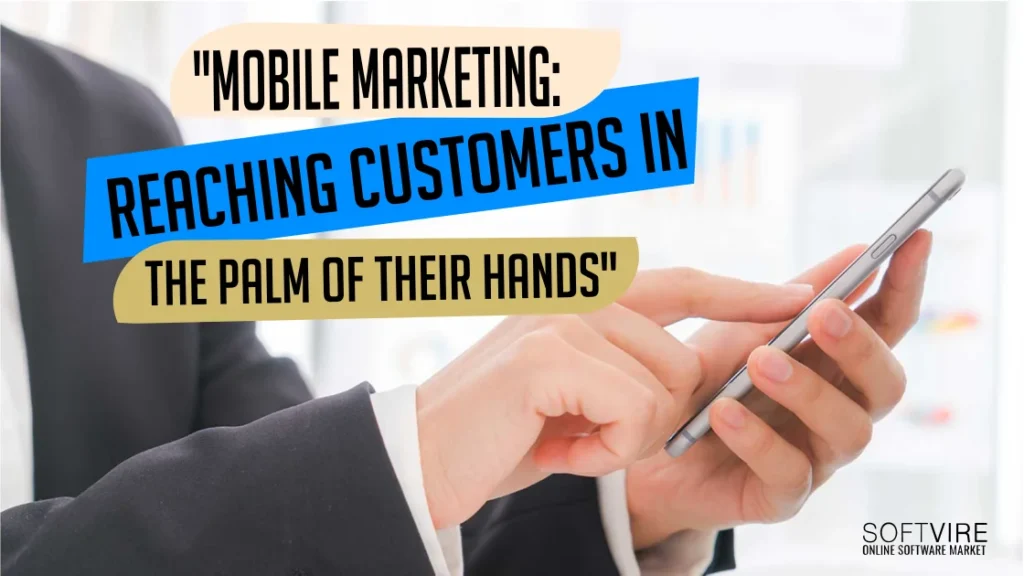Mobile marketing has become a crucial aspect of modern advertising strategies. With the widespread usage of mobile devices, it has become essential for businesses to connect with their customers through these handheld devices.
In this outline, we will explore the world of mobile marketing and how it enables businesses to reach customers in the palm of their hands.
- Definition of mobile marketing: The technique of promoting products, services, and brands via mobile devices known as mobile marketing, such as smartphones and tablets. It involves utilizing various strategies and tactics to reach and engage customers on mobile devices.
- Importance of reaching customers through mobile devices: Reaching customers through mobile devices is essential in today’s digital landscape. With the widespread use of smartphones and tablets, people are constantly connected and rely heavily on their mobile devices for information, communication, and shopping. Businesses leveraging mobile marketing effectively can tap into a vast audience, enhance customer engagement, drive conversions, and establish a competitive edge.
- Overview of the outline: The outline provides a structured framework to explore the various aspects of mobile marketing. It covers critical areas such as understanding mobile marketing, mobile consumer behavior, practical strategies, creating engaging mobile content, building mobile marketing campaigns, best practices, case studies, future trends, and a concluding recap of the main points. By following the outline, we can gain a comprehensive understanding of mobile marketing and its impact on reaching customers in the palm of their hands.
II. Understanding Mobile Marketing
- Definition and scope of mobile marketing: This section delves deeper into the Definition of mobile marketing, explaining its scope and how it differs from traditional marketing approaches. It highlights the unique characteristics and opportunities associated with mobile marketing.
- Evolution of mobile devices and their impact on marketing: The Evolution of mobile devices has revolutionized how people interact with digital content and has significantly impacted marketing practices. This subsection explores the historical development of mobile devices, from basic cell phones to sophisticated smartphones, and examines how they have transformed the marketing landscape.
- Mobile marketing statistics and trends: To gain insights into the current state of mobile marketing, this subsection presents relevant statistics and trends. It explores data on mobile device usage, app usage, advertising spending, and consumer behavior, providing a comprehensive overview of the mobile marketing landscape.
III. Mobile Consumer Behavior
- The rise of mobile usage and its impact on consumer behavior: This section delves into the increasing prevalence of mobile device usage and its profound impact on consumer behavior. It explores how mobile devices have become integral to people’s lives, affecting communication patterns, information consumption, and decision-making processes.
- Mobile shopping and purchasing habits: With the rise of mobile commerce, consumers now use their mobile devices to shop and make purchases. This subsection examines the changing consumer behavior regarding mobile shopping habits, including researching products, comparing prices, reading reviews, and completing transactions through mobile platforms.
- Mobile advertising and its effectiveness: Mobile advertising is vital in reaching and influencing consumers. This subsection explores the effectiveness of mobile advertising, discussing various ad formats and strategies businesses can employ to engage and convert mobile users effectively.
IV. Strategies for Effective Mobile Marketing
- Responsive web design and mobile-friendly content: Given the diversity of mobile devices, ensuring a seamless user experience across different screen sizes and platforms is crucial. This subsection highlights the importance of responsive web design and mobile-friendly content, providing practical tips for optimizing websites for mobile devices.
- Mobile apps and their role in marketing: They offer unique opportunities for businesses to engage with their target audience. This subsection explores the role of mobile apps in marketing, discussing the benefits of developing branded apps, providing value-added services, and enhancing customer loyalty.
- SMS marketing and push notifications: SMS marketing and push notifications enable businesses to reach customers’ mobile devices with personalized messages directly. This subsection explores SMS marketing and push notifications, discussing best practices for capturing attention, driving engagement, and promoting offers.
- Location-based marketing and geotargeting: Location-based marketing leverages mobile users’ location data to deliver targeted and relevant messages. This subsection examines the power of geotargeting, exploring how businesses can utilize location-based marketing to drive foot traffic, offer location-specific promotions, and enhance the overall customer experience.
- Mobile advertising platforms and formats: Mobile advertising platforms provide businesses with the means to reach their target audience through various formats, such as display ads, native ads, video ads, and in-app ads. This subsection explores different mobile advertising platforms, discussing their features, targeting capabilities, and best practices for creating compelling mobile ads.
V. Creating Engaging Mobile Content
- Understanding the mobile user experience: To effectively engage mobile users, businesses must understand the unique characteristics of the mobile user experience. This subsection delves into the mobile user experience, discussing factors such as limited screen space, shorter attention spans, and on-the-go interactions.
- Designing visually appealing and user-friendly mobile content: Visual appeal and usability are paramount. This subsection provides insights into designing visually appealing and user-friendly mobile content, discussing principles such as clear and concise messaging, intuitive navigation, and mobile-optimized visuals.
- Optimizing content for mobile search and discovery: Mobile search is a significant source of business traffic and discovery. This subsection explores techniques for optimizing content for mobile search engines, including mobile SEO strategies, keyword research, and content formatting considerations.
- Using multimedia and interactive elements effectively: Multimedia elements and interactive features can enhance user engagement on mobile devices. This subsection explores the effective use of images, videos, infographics, and interactive elements to capture users’ attention and convey information effectively.
- Building a Mobile Marketing Campaign
- Setting clear objectives and target audience: A successful mobile marketing campaign starts with clearly defined objectives and a deep understanding of the target audience. This subsection delves into the importance of setting specific goals and identifying the target audience’s characteristics, preferences, and behaviors.
- Developing a mobile marketing strategy: A well-crafted strategy ensures coherence and alignment with the overall marketing goals. This subsection guides developing a mobile marketing strategy, including selecting the right tactics, establishing key performance indicators (KPIs), and creating a cohesive messaging approach.
- Choosing the right mobile channels and platforms: Various mobile channels and platforms are available for businesses to reach their target audience. This subsection discusses different options, such as mobile websites, mobile apps, social media platforms, and messaging apps, providing insights into choosing the most suitable channels based on the target audience’s preferences and behavior.
- Implementing and tracking mobile marketing campaigns: Implementing a mobile marketing campaign involves executing the planned tactics and closely monitoring their performance. This subsection explores the practical aspects of campaign implementation, including campaign scheduling, budget allocation, ad placement, and tracking mechanisms for measuring key metrics.
- Testing and optimizing mobile campaigns for better results: Continuous improvement is essential in mobile marketing. This subsection highlights the importance of testing and optimizing mobile marketing campaigns, discussing techniques such as A/B testing, user feedback, data analysis, and iterative improvements to achieve better results over time.
VII. Mobile Marketing Best Practices
- Personalization and targeting in mobile marketing: Personalization and targeting are crucial for delivering relevant and meaningful experiences to mobile users. This subsection explores best practices for personalizing mobile marketing efforts, including personalized recommendations, targeted offers, and tailored messaging based on user preferences and behavior.
- Permission-based marketing and privacy considerations: Respecting user privacy and obtaining consent are integral to mobile marketing success. This subsection discusses permission-based marketing practices, including obtaining opt-ins, transparent data handling, and compliance with relevant privacy regulations.
- Integrating mobile marketing with other channels: Mobile marketing is most effective when integrated with other marketing channels. This subsection explores the benefits of integrating mobile marketing with other channels, such as social media, email marketing, and offline advertising, ensuring a consistent brand experience across different touchpoints.
- Measuring and analyzing mobile marketing performance: Measuring the effectiveness of mobile marketing efforts is crucial for optimizing campaigns and maximizing ROI. This subsection discusses key metrics and analytics tools for tracking mobile marketing performance, providing insights into data-driven decision-making and continuous improvement.
- Staying up-to-date with mobile marketing trends and technologies: Mobile marketing is a dynamic field with ever-evolving trends and technologies. This subsection emphasizes the importance of staying informed about the latest mobile marketing trends, emerging technologies such as augmented reality (AR), virtual reality (VR), and artificial intelligence (AI), and their potential impact on future mobile marketing strategies.
VIII. Case Studies and Success Stories
- Examples of successful mobile marketing campaigns: This section showcases real-life examples of successful mobile marketing campaigns. It highlights businesses that have effectively utilized mobile marketing strategies and provides insights into their approaches, tactics, and outcomes.
- Lessons learned from mobile marketing case studies: Extracting valuable lessons from them is crucial for understanding and applying best practices to future campaigns. This subsection analyzes the earlier case studies, identifying common themes, success factors, and actionable takeaways.
IX. Future Trends in Mobile Marketing
- Emerging technologies and their impact on mobile marketing: The future of mobile marketing is shaped by emerging technologies. This subsection explores cutting-edge technologies such as 5G, artificial intelligence (AI), machine learning (ML), and the Internet of Things (IoT), discussing their potential impact on mobile marketing strategies and consumer experiences.
- The growing importance of mobile-first and mobile-only strategies: Mobile-first and mobile-only strategies are becoming increasingly important as mobile usage continues to rise. This subsection examines the benefits and considerations of adopting a mobile-first approach, where businesses prioritize mobile experiences and tailor their marketing efforts accordingly.
- Predictions for the future of mobile marketing: This subsection provides insights into future trends and predictions for mobile marketing. It discusses anticipated advancements in mobile technology, changes in consumer behavior, and emerging opportunities that businesses can leverage to stay ahead in the ever-evolving mobile marketing landscape.
X. Conclusion
In conclusion, mobile marketing is pivotal in today’s digital landscape. By reaching customers through mobile devices, businesses can establish more robust connections, enhance brand awareness, and drive conversions.
The outline covered various aspects of mobile marketing, including understanding its Definition, Evolution, statistics, mobile consumer behavior, and effective strategies. Creating engaging mobile content, building mobile marketing campaigns, and following best practices were also explored.
Additionally, case studies provided practical insights, and future trends highlighted the growing importance of mobile-first approaches and emerging technologies. Overall, mobile marketing offers immense opportunities for businesses to thrive by reaching customers in the palm of their hands.
Check out the different Microsoft software products today if you need trusted software that uses AI ethically and efficiently. They continue to lead in using AI for their many office tools like Office 365. Get discounted Office 365 in Australia now!



